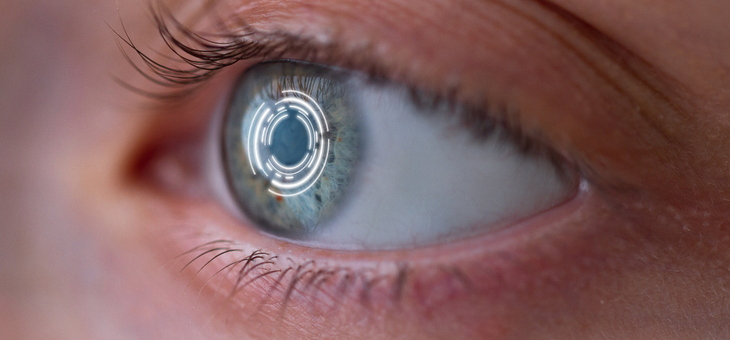Australian researchers are driving world-leading projects to restore eyesight.
A device developed by Monash University researchers, which could help restore vision to the blind, is being prepared for human clinical trials in Melbourne.
And the Centre for Eye Research Australia (CERA) has led a clinical trial that found vitamin B3 may stop glaucoma and even reverse blindness.
Many people who are clinically blind have damaged optic nerves. These prevent signals transmitted from the retina reaching the ‘vision centre’ of the brain.
Monash Vision Group (MVG) has developed the Gennaris bionic vision system, which can bypass this damage, making it possible to treat many conditions that currently have treatment limitations.
Monash researchers have developed miniaturised, wireless electronic implants, which sit on the surface of the brain and can restore vision.
It is hoped the technology might also improve health outcomes for patients with previously untreatable neurological conditions, such as limb paralysis.
“Cortical vision prostheses aim to restore visual perception to those who have lost vision by delivering electrical stimulation to the visual cortex — the region of the brain that receives, integrates and processes visual information,” said Professor Arthur Lowery, principal investigator and director of the Monash Vision Group.
“Our design creates a visual pattern from combinations of up to 172 spots of light (phosphenes), which provides information for the individual to navigate indoor and outdoor environments and recognise the presence of people and objects around them.”
MVG is seeking further government funding, aiming to provide vision to people with untreatable blindness and movement to the arms of people paralysed by quadriplegia.
The Herald-Sun has reported that CERA’s trial of nicotinamide — made from vitamin B3 — halted the progress of common eyesight disease glaucoma and found it could even “reverse some of the damage caused to the optic nerve”.
“It was also found to improve vision in people already suffering from a loss of sight.
“The breakthrough has researchers hopeful they could soon help the more than 300,000 Australians suffering from the debilitating disease.”
Glaucoma is the world’s leading cause of irreversible blindness, affecting more than 60 million people worldwide.
The trial results published in Clinical and Experimental Ophthalmology showed “significant improvement in the visual function of glaucoma patients who received a daily high dose of 3g of nicotinamide for 12 weeks in addition to their regular treatment to reduce eye pressure”.
Dr Flora Hui, from the Centre for Eye Research Australia, said a larger international trial was now needed to determine if improvement shown in the study could be sustained.
“As a safe therapy that is well tolerated by patients, vitamin B3 has potential as a clinical supplement to support patients who are receiving glaucoma treatment.’’
Dr Hui said the findings provided hope of a treatment that could protect nerve cells and help those that were already damaged to function better.
“Like adding oil to a car engine to allow it to run smoothly, vitamin B3 could be used to protect cells from damage and help those that have been affected by glaucoma work better.”
CERA is also working on a bionic eye and improvements to corneal transplants.
The MVG Gennaris system uses custom-designed headgear with a camera and wireless transmitter, a vision processor unit and software, and a set of 9×9mm tiles that are implanted into the brain.
MVG collaborator Dr Yan Wong from the Monash Biomedicine Discovery Institute said commercialisation of the system could enable exploration of treatments for moderating epilepsy and depression and brain-controlled prosthetics.
“The study results indicate that long-term stimulation through wireless arrays can be achieved without induction of widespread tissue damage, nor visible behavioural issues or seizures resulting from the stimulation,” lead author of the study, Professor Jeffrey Rosenfeld from The Alfred hospital, said.
So far, more than 2700 hours of stimulation have been performed without any observable adverse health effects.
Other sources of light
“University of Toronto Engineering researchers have developed a new method of injecting healthy cells into damaged eyes. The technique could point the way toward new treatments with the potential to reverse forms of vision loss that are currently incurable.”
“The eye is an ideal target for gene therapy. Because it is relatively self-contained, the viruses that are used to carry genes into the cells of the retina should not be able to travel to other parts of the body. And because the eye is an immune-privileged site, the immune system is less likely to mount a defence there against such a virus.”
When did you last have your eyes tested? Could the Monash University research change your life?
If you enjoy our content, don’t keep it to yourself. Share our free eNews with your friends and encourage them to sign up.
Related articles:
https://www.yourlifechoices.com.au/health/your-health/eye-test-to-detect-alzheimers
https://www.yourlifechoices.com.au/government/seniors-card/all-eyes-on-spectacle-subsidies
https://www.yourlifechoices.com.au/health/wellbeing/eyes-right

